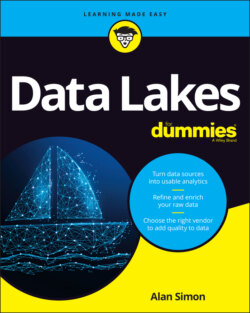Читать книгу Data Lakes For Dummies - Alan R. Simon - Страница 41
Strengthening the analytics relationship between IT and the business
ОглавлениеIf a tree falls in a forest, but nobody is around to hear it fall, does it make a sound?
Or how about this one: If you build a system to support analytics across your organization and load it with tons of data, but nobody really uses it, does your organization really have analytical data?
Don’t worry, you didn’t go back in time to a college philosophy class — you won’t be graded on your responses to either of these questions.
You can think of a data warehouse as a direct ancestor of a data lake. Data warehousing came onto the scene around 1990, and it has been the primary go-to approach for enterprise analytics in the decades since.
Far too many of today’s data warehouses are like that tree falling in a forest. The IT side of your company originally set out to build an enterprise-wide home for analytical data that will support reporting, business intelligence, data visualization, and other analytical needs from every corner of your organization.
Alas, that data warehouse, like so many others, came up short. Maybe the data warehouse doesn’t contain certain sets of data that are needed for critical analytics. Perhaps the data warehouse contents aren’t properly organized and structured and are difficult to access with the business intelligence tools available. Whatever the reason may be, your organization’s business users finally said, “To heck with it!” and built their own smaller-scale data marts to satisfy their own departmental or functional analytical needs.
Along the way, a sense of distrust built up — at least when it came to analytics and data — between your IT organization and the business users who are supposed to be their customers. Not good!
The data lake presents your organization with an opportunity for a fresh start. You can apply many of the best practices and also the painful lessons from 30-plus years of data warehousing to your data lake efforts and avoid repeating the mistakes and shortcomings of the past. As your data lake gets built, no matter if you’re on the IT side or the business side of your company, you can help rebuild that essential trust, especially when it comes to all-important analytics and the resulting data-driven insights.
